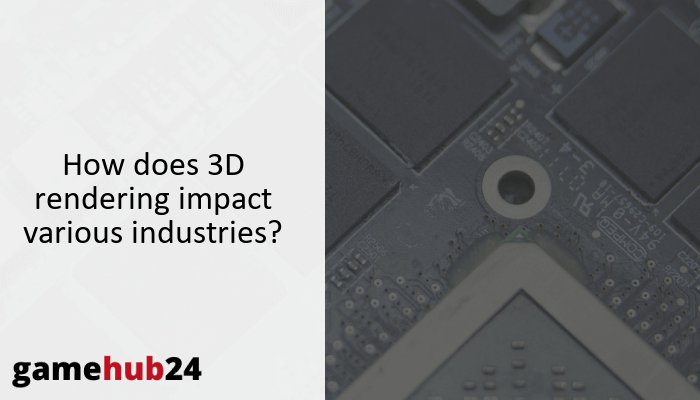A unique digital method called 3D rendering gives two-dimensional visuals the appearance of three-dimensional objects and gives them a sense of depth and reality. This method has a significant impact on the future of digital design and is essential to many industries, such as entertainment and architecture.
As a kind of digital photography, 3D rendering is a dynamic process that transforms 3D models into 2D photographs. It is an essential element in many fields, such as science, entertainment, and architecture. There are other steps in the process, such as texture mapping, computer graphics, and 3D modeling. The quality and realism of the finished product are further improved by using sophisticated techniques like photorealistic rendering and ray tracing. The development of virtual and augmented reality experiences also heavily relies on 3D rendering, which has enormous potential for use in virtual staging, printing, 3D scanning, and computer-generated imagery.
- 3D rendering transforms 3D models into 2D images, akin to digital photography.
- It’s integral to various industries, including architecture, entertainment, and science.
- The process involves 3D modeling, texture mapping, and the use of computer graphics.
- Advanced techniques like ray tracing and photorealistic rendering enhance the final output’s quality and realism.
- 3D rendering is crucial in creating virtual and augmented reality experiences.
- The future of 3D rendering holds vast potential, with applications in 3D scanning, printing, virtual staging, and CGI animation.
What is the basic understanding of 3D rendering?
Essentially, 3D rendering is the computer process of translating three-dimensional models into two-dimensional pictures. It’s like taking a digital picture of a scene that is three dimensional. The final result is greatly influenced by the objects, surfaces, and materials of the scene as well as the lighting source. This method is essential to many sectors, including entertainment and architecture, and it forms the basis of digital 3D design.
What is the role of computer graphics in 3D rendering?
3D rendering relies heavily on computer graphics. They offer the resources required to design, work with, and render 3D scenes and objects. Using programs such as Blender or Autodesk, artists can create complex virtual environments with realistic textures, lighting, and shading. Therefore, the key component holding the entire 3D rendering process together is computer graphics.
How does 3D modeling contribute to 3D rendering?
The first step towards 3D rendering is 3D modeling. It entails utilizing specialized software to create a digital representation of any surface or object in three dimensions. The basic materials used in 3D rendering are these models. The’scene’ would not exist to render without them. Consequently, the creation of realistic, high-quality computer-generated imagery relies heavily on 3D modeling.
It may surprise you to learn that some of the most widely used programs for 3D rendering are Autodesk, Blender, and Unity. Blender is recommended for its adaptability and open-source nature, whereas Unity is preferred for game design because of its real-time rendering capabilities. Autodesk is well-known for its professional-grade tools.
What is the significance of texture mapping in 3D rendering?
In 3D rendering, texture mapping is similar to wallpapering a blank wall. It entails applying textures from 2D photos to 3D objects to give them a more realistic look. This procedure can significantly increase a 3D scene’s visual complexity by giving otherwise flat surfaces depth and detail. For this reason, texture mapping is essential to producing realistic 3D visualizations.
How is 3D rendering used in different fields?
Numerous businesses can benefit from the many applications of 3D rendering. In architectural rendering, it’s utilized to produce photorealistic renderings of buildings before they’re constructed. It’s employed in the entertainment sector to produce the breathtaking images found in video games and motion pictures. 3D rendering helps in the creation of intricate models and simulations, even in the scientific domain. Its most notable attribute is its adaptability.
What is the role of 3D rendering in architectural visualization?
Architectural visualization has been changed through 3D rendering. It makes it possible for designers and architects to produce intricate, lifelike models of interior spaces and buildings before they are really built. This helps clients see the finished product as well as in design development. As a result, 3D rendering is becoming a crucial tool in contemporary architecture.
How does game design utilize 3D rendering?
The creation of immersive virtual environments in game design is mostly dependent on 3D rendering. This method gives life to every part of a video game, from the characters to the settings. Game designers may generate intricate scenes in real-time and provide gamers a flawless gaming experience by using platforms such as Unity. Thus, a key component of game design is 3D rendering.
A helpful piece of advice for anyone starting out in 3D rendering is to grasp the fundamentals of lighting and shading. These components have the power to significantly improve your renderings’ realism. To get the desired effect, experiment with various light sources and shading strategies.
What is the impact of 3D rendering on digital art?
In digital art, 3D rendering has created new opportunities. These days, artists may produce complex, three-dimensional works that stretch the bounds of imagination. The options are practically unlimited, ranging from immersive virtual installations to digital sculptures. As a result, 3D rendering has significantly changed the field of digital art and allowed creators to explore new creative avenues.
What are the advanced techniques in 3D rendering?
Technological advancements also drive advancements in 3D rendering techniques. These cutting-edge techniques, which range from ray tracing to photorealistic rendering, enable even more realistic and detailed images. Their application improves the quality and realism of 3D renderings in anything from CGI animation to architectural visualization. The state of 3D rendering technology is represented by these methods.
How does ray tracing enhance 3D rendering?
A method for simulating how light interacts with objects in a scene is called ray tracing. To produce incredibly realistic visuals, it follows the course of light rays while taking shadow, refraction, and reflection into consideration. This technology improves 3D rendering by introducing a degree of realism that is difficult to attain with conventional techniques. Ray tracing is a major development in 3D rendering technology as a result.
What is the role of photorealistic rendering in 3D visualization?
Three-dimensional rendering at its best is called photorealistic rendering. Its goal is to produce photographs that are so lifelike that they can’t be distinguished as photographs. This is accomplished by faithfully recreating materials and light, producing incredibly realistic and detailed visuals. In domains where a high degree of realism is necessary, such as architecture and product design, photorealistic rendering is essential.
How does CAD software improve 3D rendering processes?
Software for computer-aided design (CAD) has greatly enhanced the 3D rendering process. It offers a set of tools for accurately and effectively building, editing, and rendering 3D models. Designers may more quickly and effectively produce images by adjusting lighting, applying materials, and manipulating 3D models with CAD software. As a result, CAD software is essential to contemporary 3D rendering.
How does 3D rendering contribute to virtual and augmented reality?
A crucial element of virtual and augmented reality experiences is 3D rendering. The immersive 3D environments that people engage with are made with it. Three-dimensional rendering is essential to making virtual tours of buildings and augmented reality games come to life. That makes its contribution to VR and AR noteworthy.
How is 3D rendering used in virtual reality applications?
In virtual reality applications, 3D rendering is utilized to generate the immersive 3D environments that users can explore. It creates the lifelike images that are so captivating in virtual reality. Every component, including the lighting and wall texturing, is produced to produce an authentic virtual environment. Thus, the success of VR apps depends on 3D rendering.
What is the role of 3D rendering in augmented reality experiences?
3D rendering is utilized in augmented reality experiences to superimpose digital elements on the physical world. Because these items are rendered in real-time, users can interact with them just like they would with real objects. The captivating quality of augmented reality experiences stems from the smooth blending of digital and tangible components. Thus, the production of augmented reality experiences heavily relies on 3D rendering.

What is the future of 3D rendering?
3D rendering has a promising future because new tools and uses are always being developed. The possibilities are boundless, ranging from virtual staging and 3D walkthroughs to 3D scanning and printing. We should anticipate seeing 3D images that are progressively more lifelike and captivating as technology develops. There’s no denying that 3D rendering has an intriguing future.
How can 3D scanning and 3D printing benefit from 3D rendering?
3D rendering has a lot to offer 3D scanning and printing. Before being printed, scanned objects can be edited and improved upon by rendering and seeing them in three dimensions. The final printed output may be more accurate and of higher quality as a result. In a similar vein, 3D models of objects can serve as 3D printing blueprints. As a result, 3D rendering can improve the printing and scanning procedures.
What is the potential of 3D rendering in virtual staging and 3D walkthroughs?
A new horizon for 3D rendering is represented by virtual staging and 3D walkthroughs. Compared to traditional images or videos, they offer a more immersive experience by enabling potential buyers to virtually tour and visualize properties. These virtual experiences can be quite realistic with the aid of 3D rendering, which makes them an effective tool in the real estate sector. In this discipline, 3D rendering has enormous promise.
How might CGI animation evolve with advancements in 3D rendering?
CGI animation technology will progress in tandem with 3D rendering technology. Animation will be pushed to new limits with more realistic and detailed animations made possible by new rendering techniques. Future CGI animation will surely be shaped by the advancements in 3D rendering, which will result in more realistic characters and immersive landscapes.

















